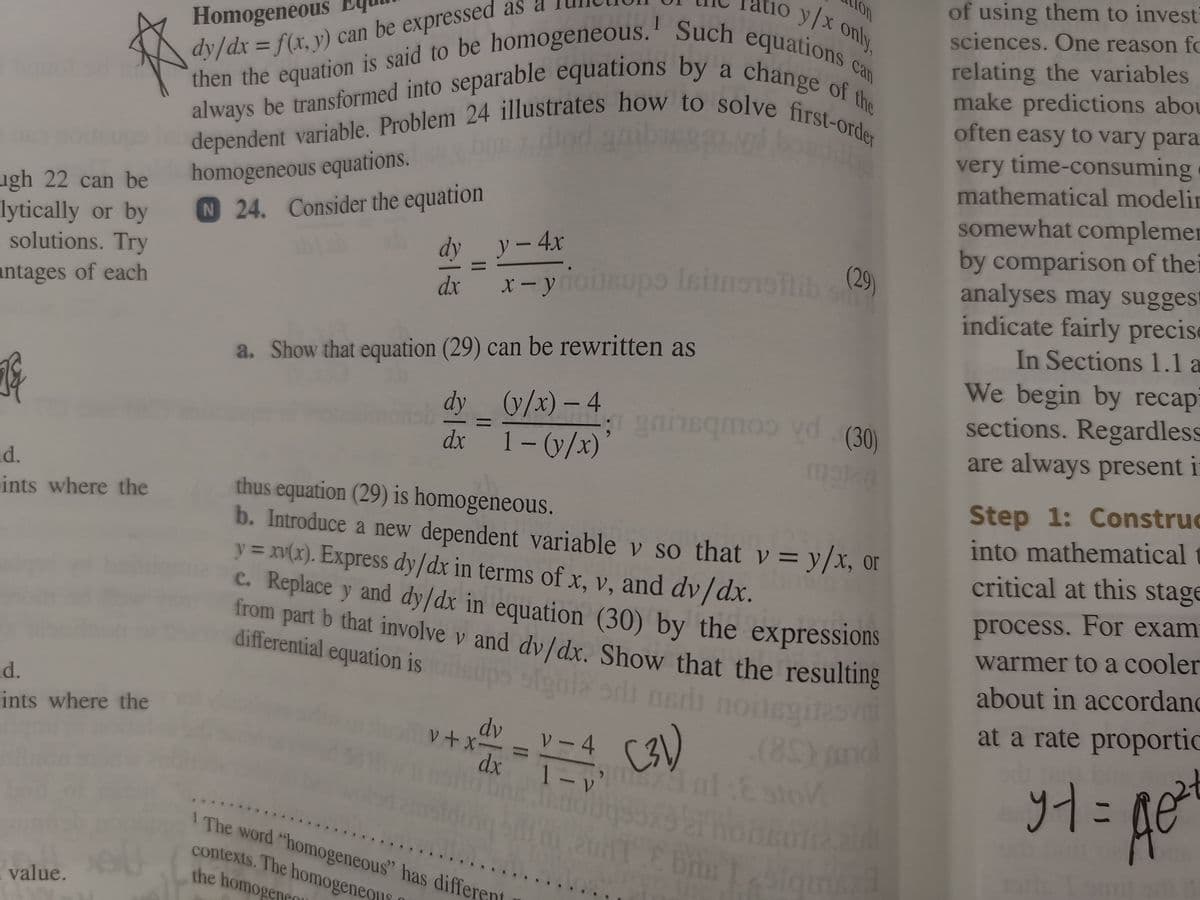N 24. Consider the equation or by s. Try E each dy y-4x x-yiousupo lsinonsi (29) dx a. Show that equation (29) can be rewritten as dy v/x) - 4 1- (y/x)* (30) dx thus equation (29) is homogeneous. b. Introduce a new dependent variable v so that v = y = xv(x). Express dy/dx in terms of x, v, and dv/dx. c. Replace y and dy/dx in equation (30) by the expressions from part b that involve v and dv/dx. Show that the resulting differential equation is re the = y/x, or noilagitesv (8Yand 1-y dalsto re the dv v+x- ソ-4 dx I The word 小一本
N 24. Consider the equation or by s. Try E each dy y-4x x-yiousupo lsinonsi (29) dx a. Show that equation (29) can be rewritten as dy v/x) - 4 1- (y/x)* (30) dx thus equation (29) is homogeneous. b. Introduce a new dependent variable v so that v = y = xv(x). Express dy/dx in terms of x, v, and dv/dx. c. Replace y and dy/dx in equation (30) by the expressions from part b that involve v and dv/dx. Show that the resulting differential equation is re the = y/x, or noilagitesv (8Yand 1-y dalsto re the dv v+x- ソ-4 dx I The word 小一本
Calculus: Early Transcendentals
8th Edition
ISBN:9781285741550
Author:James Stewart
Publisher:James Stewart
Chapter1: Functions And Models
Section: Chapter Questions
Problem 1RCC: (a) What is a function? What are its domain and range? (b) What is the graph of a function? (c) How...
Related questions
Topic Video
Question
100%
How can I get 31 from 30?

Transcribed Image Text:on
yx only,
of using them to invest
sciences. One reason fo
Homogeneous
relating the variables
make predictions abou
often easy to vary para.
then the equation is said to be homogeneous.' Such equations
dependent variable. Problem 24 illustrates how to solve first-order
always be transformed into separable equations by a change of the
can
a
change of the
%3D
dy/dx = f(x, y) can be expressed as
always be transformed into separable equations by
very time-consuming
mathematical modelin
homogeneous equations.
N 24. Consider the equation
ugh 22 can be
lytically or by
solutions. Try
somewhat complemer
by comparison of thei
analyses may suggest
indicate fairly precise
In Sections 1.1 a
dyy-4x
x-yiousupo Isinoo (29)
dx
antages of each
We begin by recapi
sections. Regardless
are always present i
a. Show that equation (29) can be rewritten as
dy (y/x) – 4
dx 1- (y/x)
qmoo vd (30)
id.
ints where the
Step 1: Construc
thus equation (29) is homogeneous.
b. Introduce a new dependent variable v so that v = y/x, or
y = xv(x). Express dy/dx in terms of x, v, and dv/dx.
c. Replace y and dy/dx in equation (30) by the expressions
from part b that involve v and dy/dx. Show that the resulting
differential equation is
into mathematical
critical at this stage
process. For exam
warmer to a cooler
about in accordand
adi nerli noilsgi129
(8Yond
dx ¯ T - v' ol Esto
d.
ints where the
at a rate proportic
dv
v+x-
ソー4
こ
I The word "homogeneous" has different
contexts. The homogeneois
the homogene
I value.
II
Expert Solution
This question has been solved!
Explore an expertly crafted, step-by-step solution for a thorough understanding of key concepts.
This is a popular solution!
Trending now
This is a popular solution!
Step by step
Solved in 2 steps with 2 images

Knowledge Booster
Learn more about
Need a deep-dive on the concept behind this application? Look no further. Learn more about this topic, calculus and related others by exploring similar questions and additional content below.Recommended textbooks for you

Calculus: Early Transcendentals
Calculus
ISBN:
9781285741550
Author:
James Stewart
Publisher:
Cengage Learning

Thomas' Calculus (14th Edition)
Calculus
ISBN:
9780134438986
Author:
Joel R. Hass, Christopher E. Heil, Maurice D. Weir
Publisher:
PEARSON

Calculus: Early Transcendentals (3rd Edition)
Calculus
ISBN:
9780134763644
Author:
William L. Briggs, Lyle Cochran, Bernard Gillett, Eric Schulz
Publisher:
PEARSON

Calculus: Early Transcendentals
Calculus
ISBN:
9781285741550
Author:
James Stewart
Publisher:
Cengage Learning

Thomas' Calculus (14th Edition)
Calculus
ISBN:
9780134438986
Author:
Joel R. Hass, Christopher E. Heil, Maurice D. Weir
Publisher:
PEARSON

Calculus: Early Transcendentals (3rd Edition)
Calculus
ISBN:
9780134763644
Author:
William L. Briggs, Lyle Cochran, Bernard Gillett, Eric Schulz
Publisher:
PEARSON

Calculus: Early Transcendentals
Calculus
ISBN:
9781319050740
Author:
Jon Rogawski, Colin Adams, Robert Franzosa
Publisher:
W. H. Freeman


Calculus: Early Transcendental Functions
Calculus
ISBN:
9781337552516
Author:
Ron Larson, Bruce H. Edwards
Publisher:
Cengage Learning